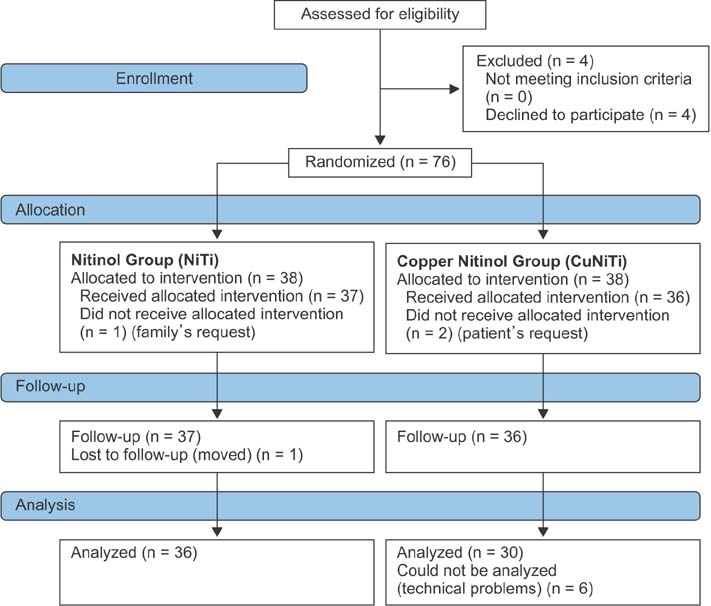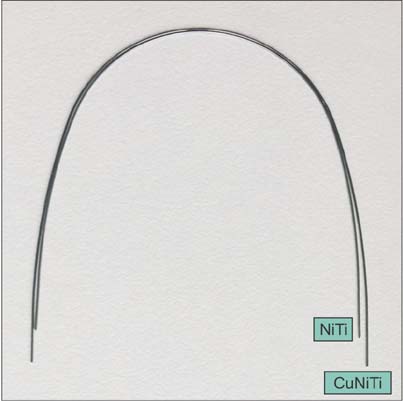Korean J Orthod.
2018 May;48(3):153-162. 10.4041/kjod.2018.48.3.153.
Evaluation of the alignment efficiency of nickel-titanium and copper-nickel-titanium archwires in patients undergoing orthodontic treatment over a 12-week period: A single-center, randomized controlled clinical trial
- Affiliations
-
- 1Department of Orthodontics, Faculty of Dentistry, Suleyman Demirel University, Isparta, Turkey. nebuydas@yahoo.com
- 2Departments of Animal Science, Genetics, and Biometrics, Faculty of Agriculture, Suleyman Demirel University, Isparta, Turkey.
- KMID: 2418326
- DOI: http://doi.org/10.4041/kjod.2018.48.3.153
Abstract
OBJECTIVE
The aim of this trial was to compare the alignment efficiency and intermaxillary arch dimension changes of nickel-titanium (NiTi) or copper-nickel-titanium (CuNiTi) round archwires with increasing diameters applied sequentially to the mandibular arch.
METHODS
The initial alignment phase of fixed orthodontic treatment with NiTi or CuNiTi round archwires was studied in a randomly allocated sample of 66 patients. The NiTi group comprised 26 women, 10 men, and the CuNiTi (27℃) group comprised 20 women, 10 men. The eligibility criteria were as follows: anterior mandibular crowding of minimum 6 mm according to Little's Irregularity Index (LII), treatment requiring no extraction of premolars, 12 to 18 years of age, permanent dentition, skeletal and dental Class I malocclusion. The main outcome measure was the alignment of the mandibular anterior dentition; the secondary outcome measure was the change in mandibular dental arch dimensions during 12 weeks. Simple randomization (allocation ratio 1:1) was used in this single-blind study. LII and mandibular arch dimensions were measured on three-dimensional digital dental models at 2-week intervals.
RESULTS
No statistically significant difference was observed between NiTi and CuNiTi according to LII (p > 0.05). Intercanine and intermolar arch perimeters increased in the CuNiTi group (p < 0.001). Inter-first premolar width showed a statistically significant interaction in week × diameter × application (p < 0.05).
CONCLUSIONS
The effects of NiTi and CuNiTi round archwires were similar in terms of their alignment efficiency. However, the intercanine and intermolar arch perimeters, and the inter-first premolar width changes differed between groups.
MeSH Terms
Figure
Reference
-
1. Yoneyama T, Miyazaki S. Shape memory alloys for biomedical applications. Cambridge: Woodhead Pub.;Boca Raton: CRC Press;2009.2. Karunakara RV. Nickel titanium wires in orthodontics: a review. J Dent Oral Biosci. 2012; 3:40–42.3. Proffit WR, Sarver DM, Fields HW. Contemporary orthodontics. St. Louis, MO: Mosby Elsevier;2007.4. McNamara JA, Brudon WL, Kokich VG. Orthodontics and dentofacial orthopedics. Ann Arbor, MI: Needham Press;2001.5. Yoneyama T, Doi H, Hamanaka H, Yamamoto M, Kuroda T. Bending properties and transformation temperatures of heat treated Ni-Ti alloy wire for orthodontic appliances. J Biomed Mater Res. 1993; 27:399–402.
Article6. Santoro M, Nicolay OF, Cangialosi TJ. Pseudoelasticity and thermoelasticity of nickel-titanium alloys: a clinically oriented review. Part I: temperature transitional ranges. Am J Orthod Dentofacial Orthop. 2001; 119:587–593.
Article7. Kusy RP. A review of contemporary archwires: their properties and characteristics. Angle Orthod. 1997; 67:197–207.8. Sachdeva R. Sure-smile: technology-driven solution for orthodontics. Tex Dent J. 2002; 119:608–615.9. Gravina MA, Brunharo IH, Canavarro C, Elias CN, Quintão CC. Mechanical properties of NiTi and CuNiTi shape-memory wires used in orthodontic treatment. Part 1: stress-strain tests. Dental Press J Orthod. 2013; 18:35–42.
Article10. Sarul M, Kowala B, Antoszewska J. Comparison of elastic properties of nickel-titanium orthodontic archwires. Adv Clin Exp Med. 2013; 22:253–260.11. O'Brien K, Lewis D, Shaw W, Combe E. A clinical trial of aligning archwires. Eur J Orthod. 1990; 12:380–384.12. Pandis N, Polychronopoulou A, Eliades T. Alleviation of mandibular anterior crowding with copper-nickeltitanium vs nickel-titanium wires: a double-blind randomized control trial. Am J Orthod Dentofacial Orthop. 2009; 136:152.e1-7. discussion 152-3.
Article13. Fernandes LM, Ogaard B, Skoglund L. Pain and discomfort experienced after placement of a conventional or a superelastic NiTi aligning archwire. A randomized clinical trial. J Orofac Orthop. 1998; 59:331–339.
Article14. Abdelrahman RSh, Al-Nimri KS, Al Maaitah EF. A clinical comparison of three aligning archwires in terms of alignment efficiency: a prospective clinical trial. Angle Orthod. 2015; 85:434–439.
Article15. Riley M, Bearn DR. A systematic review of clinical trials of aligning archwires. J Orthod. 2009; 36:42–51. discussion 15.
Article16. Ong E, Ho C, Miles P. Alignment efficiency and discomfort of three orthodontic archwire sequences: a randomized clinical trial. J Orthod. 2011; 38:32–39.
Article17. Flores-Mir C. Attaining a working archwire--which sequence? Evid Based Dent. 2007; 8:48.18. Mandall N, Lowe C, Worthington H, Sandler J, Derwent S, Abdi-Oskouei M, et al. Which orthodontic archwire sequence? A randomized clinical trial. Eur J Orthod. 2006; 28:561–566.
Article19. Waters NE. A rationale for the selection of orthodontic wires. Eur J Orthod. 1992; 14:240–245.
Article20. Papageorgiou SN, Konstantinidis I, Papadopoulou K, Jäger A, Bourauel C. A systematic review and metaanalysis of experimental clinical evidence on initial aligning archwires and archwire sequences. Orthod Craniofac Res. 2014; 17:197–215.
Article21. Sandhu SS, Shetty VS, Mogra S, Varghese J, Sandhu J, Sandhu JS. Efficiency, behavior, and clinical properties of superelastic NiTi versus multistranded stainless steel wires: a prospective clinical trial. Angle Orthod. 2012; 82:915–921.
Article22. Maltagliati LA, Myiahira YI, Fattori L, Filho LC, Cardoso M. Transversal changes in dental arches from non-extraction treatment with self ligating brackets. Dental Press J Orthod. 2013; 18:39–45.
Article23. Dalstra M, Melsen B. Does the transition temperature of Cu-NiTi archwires affect the amount of tooth movement during alignment? Orthod Craniofac Res. 2004; 7:21–25.
Article24. Fleming PS, DiBiase AT, Sarri G, Lee RT. Efficiency of mandibular arch alignment with 2 preadjusted edgewise appliances. Am J Orthod Dentofacial Orthop. 2009; 135:597–602.
Article25. Burke SP, Silveira AM, Goldsmith LJ, Yancey JM, Van Stewart A, Scarfe WC. A meta-analysis of mandibular intercanine width in treatment and postretention. Angle Orthod. 1998; 68:53–60.26. Sadowsky C, Sakols EI. Long-term assessment of orthodontic relapse. Am J Orthod. 1982; 82:456–463.
Article27. Franchi L, Baccetti T, Camporesi M, Lupoli M. Maxillary arch changes during leveling and aligning with fixed appliances and low-friction ligatures. Am J Orthod Dentofacial Orthop. 2006; 130:88–91.
Article28. Almeida MR, Futagami C, Conti AC, Oltramari-Navarro PV, Navarro Rde L. Dentoalveolar mandibular changes with self-ligating versus conventional bracket systems: a CBCT and dental cast study. Dental Press J Orthod. 2015; 20:50–57.
Article29. Lundström AF. Malocclusion of the teeth regarded as a problem in connection with the apical base. Int J Orthod Oral Surg Radiogr. 1925; 11:1022–1042.
Article30. Strang RHW. The fallacy of denture expansion as a treatment procedure. Angle Orthod. 1949; 19:12–22.
- Full Text Links
- Actions
-
Cited
- CITED
-
- Close
- Share
- Similar articles
-
- Effectiveness of laser-engineered copper-nickel titanium versus superelastic nickel-titanium aligning archwires: A randomized clinical trial
- The effect of temperature changes on force level of superelastic nickel-titanium archwires
- Mechanical properties of nickel titanium and steel alloys under stress- strain test
- Effects of heat treatment on the load-deflection properties of nickel-titanium wire
- Evaluation of cytotoxicity of electroplated stainless steel orthodontic wire





